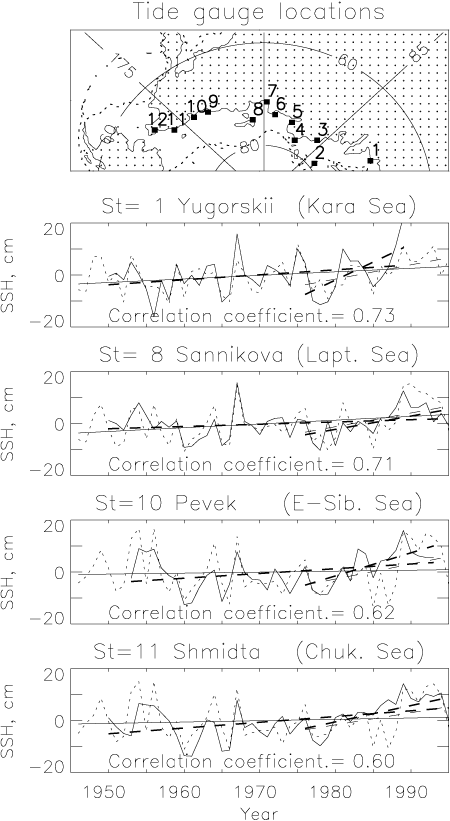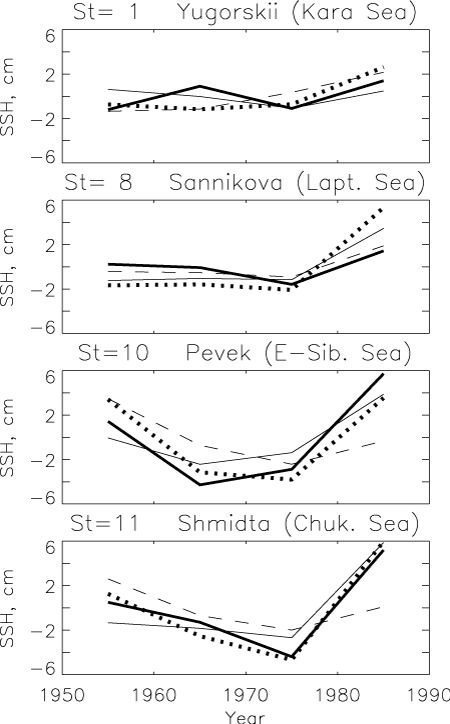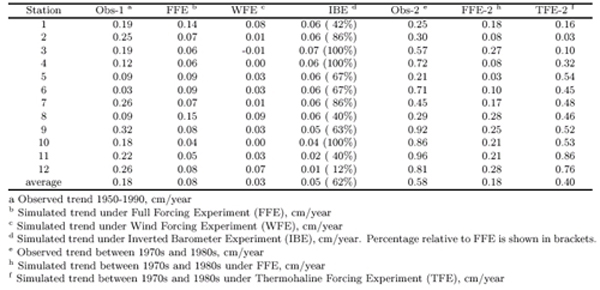| Back to WHOI Arctic Group Projects |
|
|
GEOPHYSICAL
RESEARCH LETTERS, VOL. 28, NO. 11, PAGES 2237-2240, JUNE 1,
2001
Sea level rise in the Arctic Ocean [PDF
version]
Andrey Proshutinsky
Woods Hole Oceanographic Institution, USA.
Vladimir Pavlov
Norsk Polar Institute, Tromso, Norway.
Robert H. Bourke
Naval Postgraduate School, Monterey, California, USA
Received December 11, 2000, accepted March 1,2001
|
|
|
Abstract:
About 60 tide-gauge stations in the Kara, Laptev, East-Siberian and
Chukchi Seas have recorded the sea level change from the 1950s through 1990s.
Over this 40-year period, most of these stations show a significant sea level
rise (SLR). In light of global change, this SLR could be a manifestation of
warming in the Arctic coupled with a decrease of sea ice extent, warming of
Atlantic waters, changes in the Arctic Ocean circulation, and an increase in
coastal erosion and thawing of permafrost.
We have analyzed monthly mean sea level data and assessed the role that
different factors may play in influencing the process of sea level change in the
Arctic Ocean. Analysis of the observational data and model results shows that
changes in the patterns of wind-driven and thermohaline circulation may account
for most of the increase of sea level in the Arctic Ocean and their cumulative
action can explain more than 80% of the sea level variability during 1950-1990.
© 2001 by the American Geophysical Union.
Paper number 2000GL012760.
1. Introduction

The Arctic Ocean comprises some of the most sensitive elements of the global
environment which are considered to respond rapidly to climate change. But
selecting a representative environmental parameter which can reflect both the
short- and long-term variability of arctic climate is difficult because of a
lack of continuous basin-wide observations. Sea ice extent has long been
recognized as an important indicator of the state of the Arctic climate system
in observational and modeling studies. Among recent publications, the paper by
Vinnikov, et al. (1999) can serve as an example of such an approach. Another
parameter which has been widely used for global climate change detection is the
variability in sea level. Sea level is a natural integral indicator of climate
change. It reflects changes in practically all dynamic and thermodynamic
terrestrial, oceanic, atmospheric, and cryospheric processes. This paper
assesses its role as an indicator of Arctic climate change.
 |
 |
 |
 |
 |
Figure 1. Tide gauge
locations (upper figure). Numbers show location of stations
discussed in the paper. The thick dotted line shows location
of the shelf break (200 m). Observed (solid) and simulated (dotted)
annual mean sea level time series are shown in lower figures.
The dashed thick line shows the observed trend during the period
of observations and during the last 15 years. The solid thin
line and the thin dashed line show simulated trends for the
period of simulation and for the last 15 years, respectively.
Numbers show correlation coefficient between observed and simulated
time-series. |
About 60 tide-gauge stations in the Kara, Laptev, East-Siberian and Chukchi
Seas (Siberian Seas) have recorded the sea level changes from the 1950s through
1990s (Figure 1).
The sea level data were collected by the Arctic and Antarctic Research
Institute, St. Petersburg, Russia. Over this 40-year period, most of these
stations have shown a positive trend in sea level or sea surface heights (SSH)
with an acceleration of SLR in 1970s-1990s. Data from four representative
stations are shown in Figure 1.
In light of global warming, the increase and acceleration of the rate of SLR
could be a manifestation of warming in the Arctic. As a consequence of a global
warming scenario, Shaw
et al. (1998) anticipate that a 0.65 m increase in sea level will occur
in the Canadian Arctic in the 21st century. Dvorkin
(1991) estimated the rate of SLR (during 1950-1985) from 0.02 to 0.6 mm/year
and attributed this SLR to vertical crustal movements. He predicted a 12 mm
increase in sea level due to this factor for 1990-2005.
Miller
and Russel (2000) determined the fresh and salt water budgets of the
Arctic Ocean estimated by a global climate model. Two 150-year simulations were
used to examine how this budget might change if the quantity of atmospheric
greenhouse gases (GHGs) were increased. The model indicated a SLR of 31 mm
during 1950-1999 in the Arctic Ocean due to the GHG increase. This represents
nearly half the 80 mm SLR which observations showed along the Russian
coastline during 1950-1990 (Figure 1).
They project an increase in sea level of 201 mm for the period 2000-2049,
and of 534 mm for the period 2050-2099. According to these authors, the SLR
in the Arctic Ocean is mainly due to the steric expansion associated with warmer
water (20.18 mm or 66%) and a reduction in salinity (10.91 mm or 33%).
Pavlov
and Pavlov (1999) reported a dramatic SLR acceleration in the 1980s
(Figure 1).
Pavlov
(2000) concluded that the major cause of this phenomenon was due to a change
in the thermohaline circulation. In contrast, Proshutinsky
et al. (2000) found that the SLR during this period could be explained
by changes in the atmospheric circulation, which in turn could effect the
barotropic ocean circulation causing it to become more cyclonic, decreasing the
SLP (inverted barometer effect), and increasing precipitation and river runoff.
One can see that disagreement exists among the different scientists not only
on the rates of SLR, but also on its causes. The problem is compounded because
existing observations are concentrated along the Siberian coastline and they may
not reflect changes in sea level across the whole Arctic Ocean. In assessing the
net influence of all these processes on climate change, it is essential to
consider the impact of each of the various factors individually, and to then
combine their separate contributions to provide estimates of future conditions.
It is necessary to construct a hydrological and geophysical budget for the
various contributors to local and global sea level changes.
In this paper, we analyze only the major contributors, wind stress, inverted
barometer effect and thermohaline forcing and compare their estimated inputs
with observations.
2. Wind stress and inverted barometer effects

We have investigated the role of wind stress and the gradient of SLP (the
inverted barometer effect, hereinafter, IBE) on sea level variability and
evaluated their relative contribution in terms of sea level change. A 2-D
coupled barotropic ice-ocean model having a resolution of 55.5 km [Proshutinsky
(1993)] was used for numerical experiments. The atmospheric forcing
fields were obtained from the National Center for Atmospheric Research's CDROM
containing a selected subset of the National Meteorological Center Northern
Hemisphere octagonally gridded daily surface pressure data. The model was
calibrated based on hourly sea level data for the stations mentioned above. The
model was run for the period from 1946 through 1997 with and without the IBE and
with and without the wind stress effect (WSE) to assess their role on sea level
change. The correlation between the annual mean observed and simulated sea level
variability (full forcing experiment (FFE) when both WSE and IBE were included)
for selected stations is shown in Figure 1.
Numerical experiments with and without IBE (not shown) demonstrated that wind
stress was responsible for about 60% of the sea level variability with IBE
providing the remainder. Note the significance of each of these effects depends
on the distance of the measuring station from the shelf break. The importance of
wind stress on sea level variability increases with width of the shelf (Figure 1).
There is a significant disagreement between observed and simulated sea level in
the East-Siberian and Chukchi Seas in 1985 and 1987. Wind and inverted barometer
effects were not dominating at that time and thermohaline factors were more
important (Figure 2).
The relative contribution of each factor (wind stress, ice extent, inverted
barometer effect) is also different for different seasons. Our results show that
during January-March the variability of sea level is dominated by the inverted
barometer effect because vast areas of these seas are covered by fast and pack
ice and the direct effect of wind stress on water motion is damped. Thus the
relative importance of the inverted barometer effect is regulated by the
presence of fast or compact sea ice.
A high correlation between atmospheric forcing and sea level variability
along the Siberian coastline is noted but the observed sea level trend (thick
dashed line) is greater than the simulated trend (thin solid line). Analysis of
the FFE, WFE and IBE experiments (Table 1)
demonstrated that on average the IBE explains 60% of the simulated SLR along
coastlines, and that over this 40 year period it is closely related to a trend
of a decreasing atmospheric pressure in the Arctic Ocean. Note that the wind
stress is more responsible for the short-term variability (60%) and does not
cause any significant trends in SLR during 1950-1990.
3. Thermohaline forcing and thermohaline circulation

 |
 |
 |
 |
| Figure 2. Decadal sea
level for 1950s, 1960s, 1970s and 1980s from observations (thick
solid line), and simulations based on thermohaline factors only
(thin solid line), atmopsheric forcing only (dashed line), and
combined on thermohaline and atmospheric forcing (dotted line).
Note that thermohaline forcing in the Laptev, East-Siberian
and Chukchi Seas explains more than 70% of the sea level change. |
 |
In order to investigate the sea level variability generated by changes in
thermohaline forcing, we have used a 3-D baroclinic model with a free surface [Pavlov
and Pavlov, 1999]. A set of diagnostic simulations of water circulation
and sea level fields was carried out for the 1950s, 1960s, 1970s and 1980s using
only temperature and salinity fields for these decades from the Joint
U.S.-Russian Atlas of the Arctic Ocean (1998). Figure 2
shows that observed decadal sea level variability is highly correlated with the
simulated sea level change due to variability of thermohaline factors. This
correlation steadily improves from the Kara Sea to the East-Siberian and Chukchi
Seas where it reaches more than 80%. In the Kara Sea, atmospheric forcing is
more important than the change in thermohaline circulation (Figure 1).
In the Laptev Sea both effects are important but in the East-Siberian and
Chukchi Seas the SLR is clearly more related to the change of thermohaline
circulation. It is interesting that in winter, the maximum trend in SLR is
located in the center of the ocean (about 8 cm/40 years, not shown) and in
summer, this maximum (not shown) is located in the marginal seas as might be
expected from increased river runoff, or from increased water temperature
because of the reduction of sea ice concentration and subsequent increase in
accumulation of solar radiation and ocean heat content. Areas of decreasing sea
level (negative trend, not shown) are located along the continental slope and in
the Alaskan/Canadian Arctic and on average this lowering trend compensates for
the SLR along the coastlines and in the center of the ocean.
4. Conclusions

Most of the SLR observed along the Siberian coastline during the 1950s to
1980s can be explained by atmospheric forcing and by changes in the thermohaline
circulation due to changes in the T-S distribution in the ocean. Thermohaline
and wind-driven effects are equally important in influencing the ocean
circulation and both significantly contribute to the SLR in the Arctic Ocean
over this 40-year period. Our investigation shows that in the Kara Sea (and
somewhat in the Laptev Sea) the variation in atmopsheric pressure is more
responsible for the SLR than the change in thermohaline circulation. In the
East-Siberian and Chukchi Seas, the change in thermohaline forcing prevails over
wind effects and the inverted barometer effect. This suggests that warming of
the Arctic is responsible for the SLR but not directly through land-ice melting
as one might expect. The rise in sea level is an integrated effect due to
processes associated with global warming which have changed the intensity and
direction of the atmospheric circulation, ice distribution, rates of sea ice
melting and freezing, and temperature and salinity fields.
Many secondary effects have not been taken into account in this research.
Interaction of the Arctic Ocean with the North Pacific and North Atlantic Oceans
in terms of sea level variability will be investigated in a future study using
correlation analysis among sea level time series in the Arctic Ocean and in the
Bering, Norwegian and Greenland Seas.
The sea level change due to variability in precipitation, evaporation and
river runoff must be estimated accurately as well. An example of the complexity
of this estimate can be gleaned from the interplay between storms and river
runoff. An increase of precipitation in the central Arctic, associated with the
passage of cyclonic storms, will likely lead to a reduction in river runoff from
land because the trajectories of the cyclones will be shifted towards the
central Arctic causing less precipitation to be expected over Siberia.
In addition, geological effects on sea level variability must be estimated,
perhaps based on the theory of glacial isostatic adjustment (Peltier,
1999).
The formulation and development of a conceptual model of the long term
variability in Arctic Ocean sea level is fundamentaly important for
understanding future sea level changes under differing global warming scenarios.
This paper provides a step in this effort.
|
 |
 |
|
Table 1. Observed and simulated sea level rise rates.
|
5. Acknowledgments

This research has been supported by the Wadati fund of the Geophysical
Institute, UAF, and by a grant from the Office of Naval Research (Arctic Chair
in Marine Science, 1999-2000 at the Naval Postgraduate School, Monterey, CA). It
is contribution 10420 of the Woods Hole Oceanographic Institution.
6. Bibliography

- Dvorkin et al. (1991)
- Dvorkin, E.N., Possible changes in the sea level of the Arctic seas, in:
Arctic climate regime at the 20th and 21st centuries transition,
Gidrometeoizdat, Leningrad, 150-155, 1991.
- EWG (1997,1998)
- Environmental Working Group (EWG), Joint U.S. - Russian Atlas of the
Arctic Ocean [CD-ROM], Natl. Snow and Ice Data Cent., Boulder, Colorado,
1997, 1998.
- Miller and Russel (2000)
- Miller, J.R. and G.L. Russel, Projected impact of climate change on the
freshwater and salt budgets of the Arctic Ocean by a global climate model, Geophys.
Res. Lett., 27, 8, 1183-1186, 2000.
- Pavlov (2000)
- Pavlov, V., Seasonal and interannual variability of the water circulation
and sea level of the Arctic Ocean, Geophysical Research Abstracts, vol. 2,
2000, 25 General Assembley of the European Geophysical Society, April 23-28,
Nice, France, 2000.
- Pavlov and Pavlov (1999)
- Pavlov, V.K. and P.V. Pavlov, Features of seasonal and interannual
variability of sea level and water circulation in the Laptev Sea, in: Land-Ocean
systems in the Siberian Arctic. Dynamics and History, edited by H.
Kassens, H.A. Bauch, I.A. Dmitrenko, H. Eicken, H.W. Hubberten, M. Mellers,
J. Thiede, L. Timokhov, p. 3-16, Springer-Verlag, Berlin Heidelberg, 1999.
- Peltier (1999)
- Peltier, W.R. Global sea level rise and glacial isostatic adjustment, Global
and Planetary Change, 20, 93-123, 1999.
- Proshutinsky (1993)
- Proshutinsky, A., Arctic ocean sea level variability, Gidrometeoizdat, St.
Petersburg, 216 p., 1993.
- Proshutinsky et al.(2000 )
- Proshutinsky, A., T. Proshutinsky, and M. Johnson, Arctic climate
oscillations from observations and model results, Geophysical Research
Abstracts, vol. 2, 2000, 25 General Assembley of the European Geophysical
Society, April 23-28, Nice, France, 2000.
- Shaw et al.(1998)
- Shaw, J., R.B. Taylor, S. Solomon, H.A. Christian, and D.L. Forbes,
Potential impacts of global sea-level rise on Canadian coasts, The
Canadian Geographer, 42 (4),365-379, 1998.
- Vinnikov, et al.(1999)
- Vinnikov, K.Y., A. Robock, R.J. Stouffer, J.E. Walsh, C.L. Parkinson, D.J.
Cavalieri, J.F.B. Mitchell, D. Garrett, and V. Zakharov, Global warming and
northern hemisphere sea ice extent, Science, 286, 1934-1937, 1999.

Back to WHOI Arctic Group Projects
|
|












